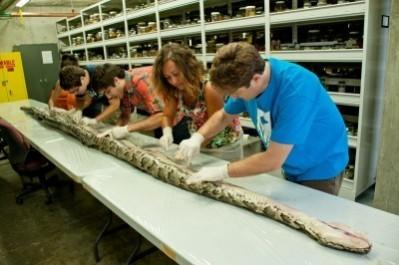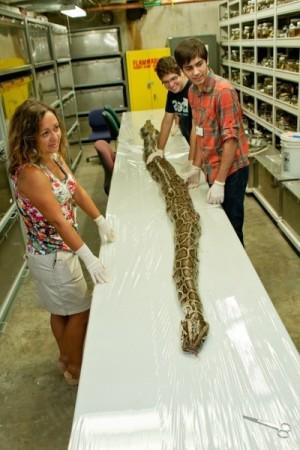
A 17-feet and 7-inch long female Burmese python carrying a record 87 eggs was found in Florida Everglades, making it the largest snake ever found in the state.
According to the University of Florida, scientists at the Florida Museum of Natural History on the campus examined the internal anatomy of 74.5 kilogram (164.5-pound) snake on Friday as a part of their long-term government research project.
"This thing is monstrous, it's about a foot wide," said Florida Museum herpetology collection manager Kenneth Krysko. "It means these snakes are surviving a long time in the wild, there's nothing stopping them and the native wildlife are in trouble."
The giant python was found out in Everglades National Park and was brought to the museum as a part of a project for managing the state's invasive Burmese python problem.
Following a scientific investigation, the reptile will be sent for display at the museum for about five years, after which the snake will be returned for display at the national park, the University said.
According to Krysko, the snake was in very good health when discovered and its stomach consisted of some feathers that will be sent to ornithologists for identification. These pythons are known for killing and eating native birds, deer, bobcats and other large animals.
"A 17.5-foot snake could eat anything it wants. By learning what this animal has been eating and its reproductive status, it will hopefully give us insight into how to potentially manage other wild Burmese pythons in the future. It also highlights the actual problem, which is invasive species," Krysko said.

Keeping in mind the rapid increase in population, the state government recently made laws prohibiting people from owning these pythons as pets or transporting them across other states without any federal permit.
However, the state residents have been given permission to hunt pythons in certain wildlife management areas during established seasons, but they should have a required permit and hunting license for that.
"They were here 25 years ago, but in very low numbers and it was difficult to find one because of their cryptic behavior," Krysko said. "Now, you can go out to the Everglades nearly any day of the week and find a Burmese python. We've found 14 in a single day."

According to a park wildlife biologist, Skip Snow, the study of the snake's biology is very important and crucial for understanding how to limit the future spread of invasive species.
"I think one of the important facts about this animal is its reproductive capability," Snow said. "There are not many records of how many eggs a large female snake carries in the wild. This shows they're a really reproductive animal, which aids in their invasiveness."
Watch the vide here:

















